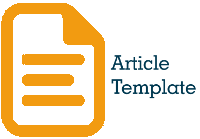Augmented Reality Based Science Learning Media Design Using Assemblr Edu Class VIII at SMPN 1 Sungai Pua
DOI:
https://doi.org/10.35457/antivirus.v18i1.3512Keywords:
Instructional Media, Augmented Reality, Assemblr EduAbstract
This research uses Research and Development (R&D) using Luther Sutopo's version of the Multimedia Development Life Cycle (MDCL). The research process was carried out at SMP Negeri 1 Sungai Pua in order to create augmented reality-based science learning media products for class VIII. Luther stated that there are six stages involved in multimedia development: concept, design, material gathering, assembly, testing, and distribution. The author succeeded in creating augmented reality-based learning materials based on research findings. The media produced in this research is not only intended for students, but teachers can also access and use it. Experts in the field of learning media design also verify the correctness of the development results. Four validators provided results and the average result was 0.84, which is included in the valid category. The practicality score for the three examiners was 0.93, which is classified as very practical, while the effectiveness result of 23 students and one teacher in science subjects was 0.92, which is classified as very effective. This product trial resulted in the conclusion that class VIII of SMP Negeri 1 Sungai Pua could benefit from the results of creating augmented reality-based science learning materials for class VIII using Assemblr Edu.
Downloads
References
[2] M. Hasan, Milawati, Darodjat, H. Khairani, and T. Tahrim, Media Pembelajaran. Klaten: Tahta Media Group, 2021.
[3] Pemerintah RI, “Undang-undang Republik Indonesia Nomor 14 Tahun 2005 tentang Guru dan Dosen.” 2005.
[4] M. T. Habibi, F. Annas, R. Okra, and H. A. Musril, “Perancangan Media Promosi Sekolah Berbasis Virtual Reality,” Intellect Indones. J. Innov. Learn. Technol., vol. 02, no. 01, pp. 17–32, 2023.
[5] A. Isman, R. Okra, S. Zakir, and L. Efriyanti, “Perancangan Media Pembelajaran Mata Pelajaran Pendidikan Jasmani Materi Pencak Silat Berbasis Augmented Reality Di SMPN 1 Koto XI Tarusan Kelas VIII,” JATI (Jurnal Mhs. Tek. Inform., vol. 7, no. 1, pp. 650–656, 2023, doi: 10.36040/jati.v7i1.6476.
[6] N. Ibrahim and I. Ishartiwi, “Pengembangan Media Pembelajaran Mobile Learning Berbasis Android Mata Pelajaran IPA Untuk Siswa SMP,” Refleks. Edukatika J. Ilm. Kependidikan, vol. 8, no. 1, pp. 80–88, 2017, doi: 10.24176/re.v8i1.1792.
[7] Gunawan and A. A. Ritonga, Media Pembelajaran Berbasis Industri 4.0. Medan: Rajagrafindo Persada, 2019.
[8] Nurdiansyah and F. Amalia, “Model Pembelajaran Berbasis Masalah Pada Pelajaran IPA Materi Komponen Ekosistem,” Pgmi Umsida, vol. 1, no. 2, pp. 1–8, 2018.
[9] A. Ridwan, “Pemanfaatan Teknologi Augmented Reality (AR) Untuk Pengenalan Aksara Lampung Pada Anak,” J. Teknol. Pint., vol. 3, no. 3, pp. 1–16, 2023.
[10] Y. Fauziah, S. Zakir, and M. Iswantir, “Pengembangan Komik Online Berbasis Webtoon Untuk Meningkatkan Pemahaman Moderasi Beragama di SMA 17 Batam,” J. Faidatuna, vol. 5, no. 1, pp. 20–36, 2024.
[11] M. Ikhbal and H. A. Musril, “Perancangan Media Pembelajaran Fisika Berbasis Android,” Inf. Manag. Educ. Prof. J. Inf. Manag., vol. 5, no. 1, p. 15, 2020, doi: 10.51211/imbi.v5i1.1411.
[12] M. Zakir and H. A. Musril, “Perancangan Media Pembelajaran Produk Kreatif Dan Kewirausahaan Berbasis Android Di SMK Elektronika Indonesia Bukittinggi,” J. Edukasi Elektro, vol. 4, no. 2, pp. 153–157, 2020, doi: 10.21831/jee.v4i2.35371.
[13] S. Afrianti and H. A. Musril, “Perancangan Media Pembelajaran TIK Menggunakan Aplikasi Autoplay Media Studio 8 di SMA Muhammadiyah Padang Panjang,” J. Inform. Upgris, vol. 6, no. 2, pp. 2–7, 2021, doi: 10.26877/jiu.v6i2.6471.
[14] W. Untoro, I. P. Satwika, A. A. A. P. Ardyanti, and W. Sujarwo, “Perancangan Game Bedugul Forest Dengan Metode Pengembangan Multimedia Luther-Sutopo,” ANDHARUPA J. Desain Komun. Vis. Multimed., vol. 5, no. 02, pp. 276–290, 2019, doi: 10.33633/andharupa.v5i2.2334.
[15] I. Solikin and R. Amalia, “Materi Digital Berbasis Web Mobile Menggunakan Model 4D,” Sistemasi, vol. 8, no. 3, pp. 321–328, 2019, doi: 10.32520/stmsi.v8i3.461.
[16] M. Megawati, L. Efriyanti, Supriadi, H. A. Musril, and S. M. Dewi, “Perancangan Media Pembelajaran TIK Kelas XI Menggunakan Google Sites di SMA Negeri 1 Junjung Sirih,” Indones. Res. J. Educ., vol. 2, no. 1, pp. 164–175, 2022, doi: 10.31004/irje.v2i1.256.
[17] A. Rahma Sari, R. Okra, H. Antoni Musril, and S. Derta, “Perancangan Media Pembelajaran Biologi Berbasis Augmented Reality (Ar) Menggunakan Assemblr Edu Di Sma Negeri 1 Bukittinggi,” JATI (Jurnal Mhs. Tek. Inform., vol. 7, no. 2, pp. 1387–1394, 2023, doi: 10.36040/jati.v7i2.7247.
[18] D. S Oktavia, S. Zakir, S. Supriadi, and L. Efriyanti, “Perancangan Media Pembelajaran Ipa Kelas Viii Menggunakan Aplikasi Canva Dengan Model Microblogging Di Smpn 1 Lubuk Alung,” JATI (Jurnal Mhs. Tek. Inform., vol. 7, no. 3, pp. 1764–1769, 2023, doi: 10.36040/jati.v7i3.7707.
[19] E. L. Putri, S. Derta, H. A. Musril, and R. Okra, “Perancangan Media Pembelajaran IPA Kelas VII Berbentuk Game Edukasi Menggunakan Aplikasi Construct 2 di SMPN 7 Bukittinggi,” Inf. Manag. Educ. Prof. J. Inf. Manag., vol. 7, no. 2, p. 194, 2023, doi: 10.51211/imbi.v7i2.2218.
Downloads
Published
Issue
Section
License
Authors who publish with this journal agree to the following terms:
- Copyright on any article is retained by the author(s).
- Author grant the journal, right of first publication with the work simultaneously licensed under a Creative Commons Attribution License that allows others to share the work with an acknowledgement of the work’s authorship and initial publication in this journal.
- Authors are able to enter into separate, additional contractual arrangements for the non-exclusive distribution of the journal’s published version of the work (e.g., post it to an institutional repository or publish it in a book), with an acknowledgement of its initial publication in this journal.
- Authors are permitted and encouraged to post their work online (e.g., in institutional repositories or on their website) prior to and during the submission process, as it can lead to productive exchanges, as well as earlier and greater citation of published work.
- The article and any associated published material is distributed under the Creative Commons Attribution-ShareAlike 4.0 International License











